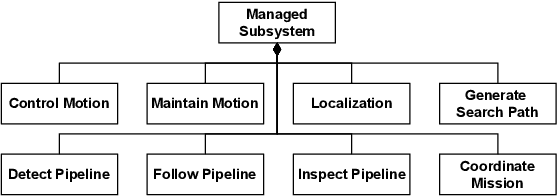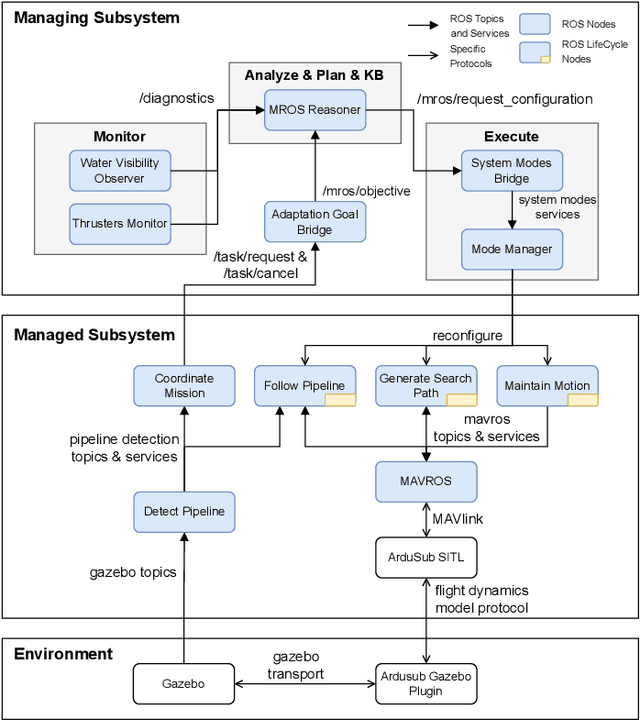Gustavo Rezende Silva
ROSA: A Knowledge-based Solution for Robot Self-Adaptation
Apr 29, 2025Abstract:Autonomous robots must operate in diverse environments and handle multiple tasks despite uncertainties. This creates challenges in designing software architectures and task decision-making algorithms, as different contexts may require distinct task logic and architectural configurations. To address this, robotic systems can be designed as self-adaptive systems capable of adapting their task execution and software architecture at runtime based on their context.This paper introduces ROSA, a novel knowledge-based framework for RObot Self-Adaptation, which enables task-and-architecture co-adaptation (TACA) in robotic systems. ROSA achieves this by providing a knowledge model that captures all application-specific knowledge required for adaptation and by reasoning over this knowledge at runtime to determine when and how adaptation should occur. In addition to a conceptual framework, this work provides an open-source ROS 2-based reference implementation of ROSA and evaluates its feasibility and performance in an underwater robotics application. Experimental results highlight ROSA's advantages in reusability and development effort for designing self-adaptive robotic systems.
Runtime Architecture and Task Plan Co-Adaptation for Autonomous Robots with Metaplan
Dec 16, 2023Abstract:Autonomous robots need to be able to handle uncertainties when deployed in the real world. For the robot to be able to robustly work in such an environment, it needs to be able to adapt both its architecture as well as its task plan. Architecture adaptation and task plan adaptation are mutually dependent, and therefore require the system to apply runtime architecture and task plan co-adaptation. This work presents Metaplan, which makes use of models of the robot and its environment, together with a PDDL planner to apply runtime architecture and task plan co-adaptation. Metaplan is designed to be easily reusable across different domains. Metaplan is shown to successfully perform runtime architecture and task plan co-adaptation with a self-adaptive unmanned underwater vehicle exemplar, and its reusability is demonstrated by applying it to an unmanned ground vehicle.
MROS: A framework for robot self-adaptation
Mar 16, 2023Abstract:Self-adaptation can be used in robotics to increase system robustness and reliability. This work describes the Metacontrol method for self-adaptation in robotics. Particularly, it details how the MROS (Metacontrol for ROS Systems) framework implements and packages Metacontrol, and it demonstrate how MROS can be applied in a navigation scenario where a mobile robot navigates in a factory floor. Video: https://www.youtube.com/watch?v=ISe9aMskJuE
SUAVE: An Exemplar for Self-Adaptive Underwater Vehicles
Mar 16, 2023



Abstract:Once deployed in the real world, autonomous underwater vehicles (AUVs) are out of reach for human supervision yet need to take decisions to adapt to unstable and unpredictable environments. To facilitate research on self-adaptive AUVs, this paper presents SUAVE, an exemplar for two-layered system-level adaptation of AUVs, which clearly separates the application and self-adaptation concerns. The exemplar focuses on a mission for underwater pipeline inspection by a single AUV, implemented as a ROS2-based system. This mission must be completed while simultaneously accounting for uncertainties such as thruster failures and unfavorable environmental conditions. The paper discusses how SUAVE can be used with different self-adaptation frameworks, illustrated by an experiment using the Metacontrol framework to compare AUV behavior with and without self-adaptation. The experiment shows that the use of Metacontrol to adapt the AUV during its mission improves its performance when measured by the overall time taken to complete the mission or the length of the inspected pipeline.
 Add to Chrome
Add to Chrome Add to Firefox
Add to Firefox Add to Edge
Add to Edge